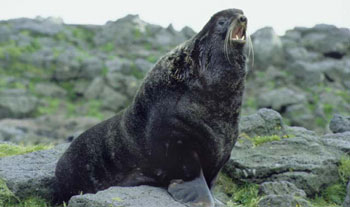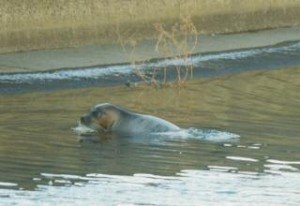Man-Eating River Monsters of Japan
Posted by: mystery_man on May 28th, 2011
Man-Eating River Monsters of Japan
By- Brent Swancer
There are many mysterious monsters dwelling in the lakes and rivers of the world, but the ones that really intrigue and terrify us are the ones that are purported to attack humans. When a cryptid goes from an undiscovered organism to a man eater, it becomes not only a mystery, but a menace. It becomes something that not only lurks in the murky depths, but in our nightmares as well.
Stories of man eating creatures inhabiting the waterways of Japan have been around since the time of the samurai. At an exhibition at the Kawasaki City Museum entitled “Japan’s Mythical Creatures- Accounts of Unidentified Organisms,” there was a curious old account from 1834 concerning a strange and terrifying animal lurking in a marshland near Tokyo, Japan. This 1834 account tells of a group of samurai who were digging a canal near the Inba Marsh in Chiba prefecture, Japan when they were ambushed by a vicious, seal-like monster. The creature was described as being 5 meters long, and looking like a large seal with a face like a monkey. Whatever it was turned out to be highly aggressive, and according to the account it savagely attacked and killed 12 of the samurai.

12 of these guys.
It is not known what became of the monster, and there are no details as to whether it was ultimately subdued, or if it escaped into the bloodied marsh.
This seems like a truly frightening and harrowing account. What sort of creature would, or could, kill 12 well armed samurai warriors? As bizarre as it may sound, there are other stories of river dwelling beasts attacking humans in Japan as well.
An unidentified river in Japan was once said to be inhabited by a population of strange creatures said to be 4 to 5 feet long, with a scaly, fish-like body and human looking hair on their heads. These bizarre beasts were said to be amphibious, and would come onto the banks of the river to engage in rowdy, boisterous behavior. The creatures were described as being very loud, filling the air with their barking cries.
They were also man killers. In addition to playing and fighting amongst themselves, the strange river creatures were said to be highly aggressive towards humans and would outright attack anyone who came near. It was said that anyone who came across these beasts was attacked and disemboweled, yet oddly the bodies were not eaten.
Is there any way these two reports might be linked somehow? And what sort of creatures could have been behind such horrific accounts?
The descriptions and size of the beasts seem to fit in somewhat with perhaps a type of pinniped. David Heppel, former curator of Molluscs at the Royal Museum of Scotland suggested that the boisterous river killers of the second case might perhaps be dramatic, embellished accounts of Northern fur seals (Callorhinus ursinus). These pinnipeds do inhabit northern Japanese waters, in the Sea of Okhotsk, and are known to breed in the Kuril and Sakhalin islands near Japan’s Hokkaido. Perhaps some of these animals made their way far south and ended up in the river somehow. The reports of the mystery beasts climbing onto shore and the loud, boisterous behavior certainly sounds like fur seals.

Northern fur seal
These animals could also account for the huge creature found in the Inba marsh. Male fur seals are quite large, attaining sizes of up to 2.1 meters (7 feet). An out of place large specimen could seem quite monstrous and mysterious to someone not accustomed to seeing one.
It would not be completely unusual for a pinniped to end up far from its normal habitat, and indeed this has happened in Japan before. In 2002, an out of place male Bearded Seal was sighted in the Tama River in Tokyo Japan. It was subsequently sighted by a large number of people and became a media sensation and somewhat of a celebrity at the time. Thousands of people would gather for a chance to catch a glimpse of the seal, which was nicknamed “Tama Chan” by the adoring public. Tama-Chan moved into other rivers of the area as well, where it became a regular sight.

Tama-chan
The case of Tama-chan is remarkable in that the native habitat of Beaded Seals is typically much farther North, in Arctic waters. Tama-chan was so far out of its range that there was speculation as to whether it would even survive in a Tokyo river in the summertime. Tama- chan did survive, and seemed to take quite well to its’s new home, finally taking up a permanent residence in the Arakawa River.
Nobody is sure how Tama-chan ended up in a Tokyo river, but it illustrates the possibility of pinnipeds ending up far out of their range in places where you would not expect to find one. This could explain other mystery river creatures in Japan, such as the Matsudodon, a strange seal-like creature with a cat’s face that was sighted along Tokyo’s Edo River in the 70s.
If these old accounts of man eating river creatures are the result of out of place pinnipeds, we are still faced with a perplexing facet of the reports. Fur seals are not aggressive man-eaters, and pinnipeds in general are not typically dangerous to humans. It is certainly hard to imagine them attacking groups of samurai or disemboweling humans that got too close. Most species of pinniped are shy towards humans, and would be more inclined to escape than boldly attack. The aggressive behavior described in these accounts certainly raises an eyebrow.
Out of place pinnipeds or something else? Whatever the cause behind these old man-eater accounts, it certainly makes one think twice about taking a dip.
About mystery_man









What if it were mating season? Would a male looking for a mate or protecting a harem be aggressive towards humans?
I think the samurai story was exaggerated a bit, as often happens with retellings of old tales, but if they were in full armor it might be possible that a large, randy, male took them for either competition or a threat and tried to ‘duel’ with one or two. If he had any sort of tusks I could easily see the disemboweling happening.
Very interesting. Out of place pinnepeds, otarids, and even otters or sea-mink of unusual size, certainly sounds like a reasonable explanation for some of these occurances, though my current reading suggests that our modern notion of just what some northern species natural range is, or was particularly in the early holocene and right up until the reletively recent birth of modern observational field biology, leads me to wonder if it’s not more a case of some creatures re-claiming ancestral territories. What remains of the original inventory of near shore creatures along coastlines long occupied by humans who fished and hunted on the oceans is a mere shadow of what it was. Maybe some of these populations will recover and reclaim anestral ranges, if only very very slowly. Last years documented sighting of what seemed to be a Gray Whale in the eastern Mediterranean Sea suggests that surprising things can still happen. Cheers
If they were just digging a canal, they most likely weren’t in armor. Suddenly killing 12 of them doesn’t seem THAT difficult.
Dogu 4- Well, actually they may have been in armor, and at the very least armed. There is no mention as to why they were digging a canal, and if samurai were doing this, it may have had some sort of defensive or offensive reason. Depending on the reasons they were out there, they could very well have been doing this in armor. The armor was not only for defense but also a matter of pride and ceremony. So it’s difficult to say if they had removed it all in this instance.
Also Samurai were never far from their weapons and were always ready to defend themselves at a moment’s notice in any situation. There is no way they would have been out there without being armed.
So depending on the circumstances, they may not have been in full battle regalia, but they were most definitely not completely defenseless.
Also, if they were digging under threat of attack, they probably were doing this in armor. They may also have been merely overseeing the digging of the canal and not actually doing the menial work themselves.
They would have been armed in any case, and killing them would be no easy feat.
Sorry, my comments were not aimed at Dogu 4, but rather doc_panda13.
This could be Japan’s version of the Australian “Bunyip”.
See below illustration which certainly matches the description above article if anything does …
At times, the description of the bunyip has been described as what could easily be interpreted as an extremely large species of otter (perhaps recently extinct within the last few centuries) the bunyip is often attributed having a head of a cat and dangerous to man. The giant river otters of the Amazon have a slight resemblance to the felidae (perhaps even moreso do these giant species).
I agree with Dogu4 on the Oterid idea, in theory, a giant otter (3 meters long/10 or more feet long) would be far more capable of capturing and dispatching a group of humans than a pinniped and are also social, noisy and playful. The habitat also sounds more suitable to a type of otter
Additionally to support the idea of some species of unknown giant otter…
Amazon Giant River Otters…
Males are between 1.5 and 1.8 meters (4.9–5.9 feet) in length and females between 1.5 and 1.7 m (4.9–5.6 ft).
Information on vocalizations supported….
Some photos of Amazon River Otters…
Here’s 2 compared to a rather large Caiman…
Here’s one with a monkey like expression. =)
the cultural importance of their arms and armour notwithstanding, it is far too impractical to consider that samurai would be fully geared when doing heavy manual labour in a non-combat setting. of course they were unarmed IF they were digging a canal. on the flipside, perhaps they were supervising a peasant labour force?
they could not wear their armour all the time… what did they wear when they sent their armour out for dry-cleaning? :p
a bit bemused by the use of the word “disemboweling”… a rather specific attack usually reserved to large cats or horned/ tusked prey animals acting in defense. more than likely i chalk this up to shoddy, sensationalistic journalism. most animals attack extremities (hands, arms, legs, heads and neck), as the torso is normally too large and awkward to access or get a jaw around.
that said, great anecdotes. if a colony of pinnipeds or otariids had taken residence in a known unusual location, perhaps a dig for skeletal evidence would be in order? a marsh should be a good medium for evidence preservation.